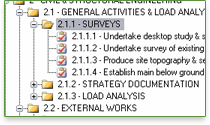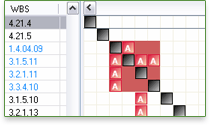 |
A work breakdown structure (WBS) is defined and for each of the activities in the project properties such as responsibility and duration are defined. Relationships between activities are then established which in turn allows the sequence through the process to be defined. |
 |
 |
 |
 |
A matrix approach to sequencing the design process is used. A sequence of activities is calculated which minimises the iteration in the design process and ensures any assumptions which the team need to make are ones which can be made with confidence. This is achieved by weighting the dependencies between activities. The calculation of a sequence, including clusters of inter-related tasks, prioritises the availability of outputs associated with the most critical dependencies. The interdependent, iterative groups of activities which remain in the process following sequencing are typically multi-disciplinary. They represent points in the design process where design team members should work concurrently to solve the interdependent problem. Usually they also represent elements of the construction, and therefore of the design output, which require co-ordination. |
 |
 |
 |